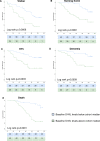Serum Neurofilament Light Chain as a Marker of Progression in Parkinson's Disease: Long-Term Observation and Implications of Clinical Subtypes
- PMID: 34806619
- PMCID: PMC8925110
- DOI: 10.3233/JPD-212866
Serum Neurofilament Light Chain as a Marker of Progression in Parkinson's Disease: Long-Term Observation and Implications of Clinical Subtypes
Abstract
Background: Biochemical and clinical biomarkers correlate with progression rate and disease severity in Parkinson's disease (PD) but are not sufficiently studied in late PD.
Objective: To examine how serum neurofilament light chain (S-NfL) alone or combined with clinical classifications predicts PD outcome in later disease stages.
Methods: Eighty-five patients with 7.9±5.1 years of PD duration were included in an observational cohort. Clinical scores were obtained at two separate examinations 8.2±2.0 years apart. S-NfL levels were determined with single molecule array (SiMoA). Five predefined disease progression milestones were assessed. After affirming combination potential of S-NfL and either of two clinical classifications, three combined models were constructed based on these factors and age at onset in different combinations.
Results: S-NfL levels showed significant hazard ratios for four out of five disease progression milestones: walking-aid usage (HR 3.5; 95% CI 1.4-8.5), nursing home living (5.1; 2.1-12.5), motor end-stage (6.2; 2.1-17.8), and death (4.1; 1.7-9.7). Higher S-NfL levels were associated with lower ability in activities of daily living and poorer cognition at baseline and/or at follow-up. Combined models showed significantly improved area under receiver operating characteristic curves (0.77-0.91) compared to S-NfL levels alone (0.68-0.71) for predicting the five disease milestones.
Conclusion: S-NfL levels stratified patients according to their likelihood to reach clinically relevant progression milestones during this long-term observational study. S-NfL alone reflected motor and social outcomes in later stages of PD. Combining S-NfL with clinical factors was possible and exploratory combined models improved prognostic accuracy.
Keywords: Parkinson’s disease; biomarkers; dementia; mortality; neurofilament proteins; prognosis.
Conflict of interest statement
OH has acquired research support (for the institution) from AVID Radiopharmaceuticals, Biogen, Eli Lilly, Eisai, GE Healthcare, Pfizer, and Roche. In the past 2 years, he has received consultancy/speaker fees from AC Immune, Alzpath, Biogen, Cerveau and Roche. AP has received reimbursement from Elsevier Ltd. for work as Associate Editor for the journal Parkinsonism & Related Disorders. All other authors report no conflict of interest.
Figures



References
-
- Greenland JC, Williams-Gray CH, Barker RA (2019) The clinical heterogeneity of Parkinson’s disease and its therapeutic implications. Eur J Neurosci 49, 328–338. - PubMed
-
- Puschmann A, Brighina L, Markopoulou K, Aasly J, Chung SJ, Frigerio R, Hadjigeorgiou G, Koks S, Kruger R, Siuda J, Wider C, Zesiewicz TA, Maraganore DM (2015) Clinically meaningful parameters of progression and long-term outcome of Parkinson disease: An international consensus statement. Parkinsonism Relat Disord 21, 675–682. - PubMed
-
- Thenganatt MA, Jankovic J (2014) Parkinson disease subtypes. JAMA Neurol 71, 499–504. - PubMed
-
- Parnetti L, Gaetani L, Eusebi P, Paciotti S, Hansson O, El-Agnaf O, Mollenhauer B, Blennow K, Calabresi P (2019) CSF and blood biomarkers for Parkinson’s disease. Lancet Neurol 18, 573–586. - PubMed
-
- Lawton M, Ben-Shlomo Y, May MT, Baig F, Barber TR, Klein JC, Swallow DMA, Malek N, Grosset KA, Bajaj N, Barker RA, Williams N, Burn DJ, Foltynie T, Morris HR, Wood NW, Grosset DG, Hu MTM (2018) Developing and validating Parkinson’s disease subtypes and their motor and cognitive progression. J Neurol Neurosurg Psychiatry 89, 1279–1287. - PMC - PubMed
Publication types
MeSH terms
Substances
LinkOut - more resources
Full Text Sources
Medical

